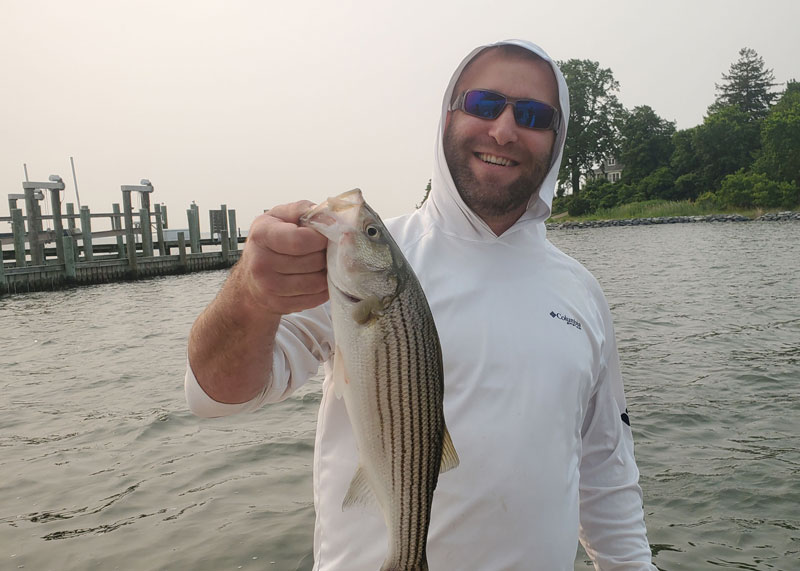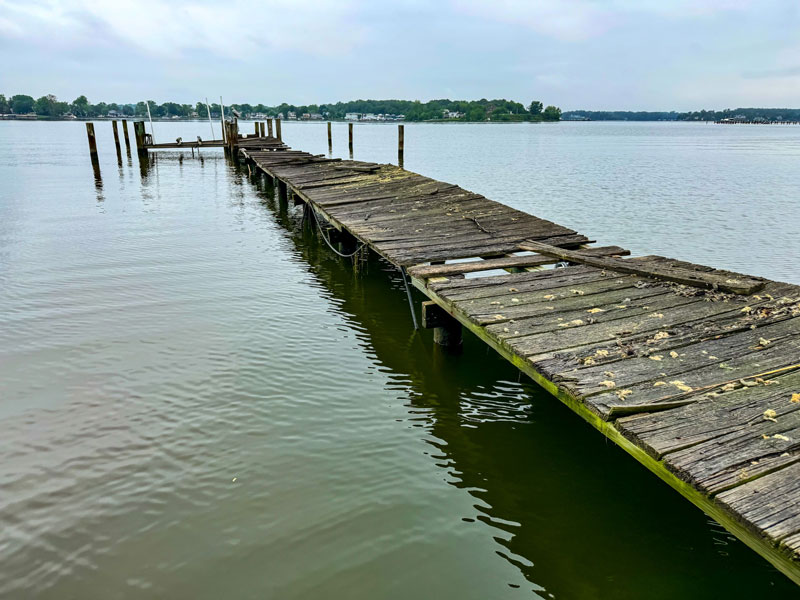Docks offer built-in habitat for small fish and crustaceans, which then attracts predator species like striped bass looking for an easy meal or a place to hide from the bright sun. Whether it was playing the video game “Bassin’s Black Bass with Hank Parker” on Super Nintendo when I was very young, fishing in the pond on a family vacation, or out kayaking here in Maryland, I have always liked fishing docks. Today, docks are my go-to structure on hot sunny days, particularly in the summer.

I am frequently surprised by the diversity of fish species I find fishing docks; each year seems to be different. Sometimes there are stripers ranging from fingerlings up to mid-20 inches, other times channel catfish grab my lure, puppy drum appear in dryer years where the salinity is high, or there might be all the white perch you can stand. My personal best for several species has come while fishing docks. While fishing docks is often a case of trial and error, there are a few tips you can follow to maximize the bite and catch fish when nothing else seems to be working.
If you have the time, my recommendation is to fish as many docks as you can — leave no stone unturned — because there is no way to predict which dock has a bunch of fish, or a big fish, or perhaps nothing at all. However, time is often in short supply and there are certain things you can look for that make one dock more appealing than another. First and foremost, the older and more decrepit the dock, the better it is likely to be. Brand new docks need a couple of years to grow barnacles and algae to attract grass shrimp, crabs, and small baitfish. Meanwhile, a dock that has been in place for a long time has built up an ecosystem that attracts fish.
When I search for docks, I also look for a distinct lack of use by the local residents. The most obvious thing you will see is a big section missing, which prevents anyone from going out to the end of the pier. Other signs to look for are lots of bird scat and birds themselves — they like to hang out where they won’t be bothered. Some of the best docks I have fished used to be docks, but now have no decking, and are just a group of pylons. Docks that obviously get lots of use and have rod holders, boats, or jet skis are the ones you save for last.

Before you go out, you can do some research using Google maps and Navionics. Checking the depths and what other structure is available will allow you to check a spot without casting blindly. It has been my experience that a dock that starts shallow and drops to deeper water, particularly more than 10’, will hold better fish. Deeper water is cooler, and on a hot summer day, cool and shady is what fish seek. Even if the dock does not extend into the deeper water, having it nearby makes the dock an enticing spot.
As a kayak angler, I have an advantage fishing docks over a powerboat. I see boaters anchor near docks, and they are only able to fish one area, having to pull and reset the anchor to fish every section. If they are drifting, the boat usually moves out of the spot quickly. A trolling motor with Spot-Lock helps, but not everyone has it. A more maneuverable kayak can get up close and keep a lure in the strike zone for longer, and if I do not have too many extra rods, I can deal with a fish that has wrapped itself up in a pylon.
When fishing these docks, my advice remains the same from the beginning — leave no stone unturned. If you can access a section of pylons, fish them. Probabilities aside, you don’t know when or why a fish will be where it is, at least at first. As you fish and patterns unfold, you can be more discerning and go right for what you think is working.
I mostly fish artificial lures and jigs under docks. A paddletail on a jig is the most versatile, such that you can change the size to fit the type of fish you want. You can also fish it slow or fast, depending on what fish is there. However, I generally fish the lightest jig I can get away with. Unless I have found a spot that goes down 10’ to 15’, I rarely fish something larger than half-ounce. If you are fishing a lure with a steady retrieve, such as a Beetle Spin or a lipless crankbait, it’s a good idea to cast well past where you think the fish will be to give them more time to see it coming. If you are going to use live or cut bait, try using single-hook rigs to avoid snagging and to keep things simple.
My favorite dock rod is a six-foot medium action. A shorter rod is more accurate for precise casting and is easier to work a fish. It might be light for bigger stripers and catfish, but it is a good all-around choice for smaller fish like spot and perch on up to decent-sized stripers, redfish, and others.
Lastly, let’s talk etiquette. Docks in the Chesapeake and its tributaries are on public water and you have the right to fish them. However, you may not get onto someone’s private dock without permission to retrieve a snagged rig. Most people are generally friendly but some entitled owners do not want you to be around their dock period, and they are not shy about telling you. Legal or not, you may be pestered — I had one lady say to me, “Why don’t you go out with the REAL fishermen?!” and did not stop insulting me until I left. Or, they might start dropping things in the water to disrupt the fishing. In my experience, it is best to move along and try another dock. Let them be miserable grouches who do not understand the joy of fishing — there are plenty of other docks out there.
- By Peter Turcik